
Dossiers
 |
Dossier Dossiers |
|
La persistenza del melodramma: da Sirk a Fassbinder a Haynes |
The persistence of melodrama: from Sirk to Fassbinder to Haynes |
|
Note: - E' disponibile una versione pdf di questo Dossier. - Il simbolo |
Notes: - A pdf version of this Dossier is available. - The symbol |
|
1. Introduzione I film che possiamo definire "melodrammi a tutti gli effetti", come quelli classici degli anni '50, sono forse più rari oggi; come nel caso di altri generi cinematografici, sono stati spesso oggetto di un processo di ibridazione, incorporando aspetti, sia in termini di forma/stile che in termini di trame e personaggi, di altri generi. Anche le reazioni del pubblico sono cambiate, sebbene sia ancora molto sentita la necessità di film che infiammino sentimenti ed emozioni a beneficio degli spettatori alla ricerca di un forte coinvolgimento emotivo. Di conseguenza, e all'interno della tendenza generale dei generi cinematografici "misti", può essere abbastanza difficile (e forse altrettanto inutile) etichettare un particolare film come "sentimentale", "romantico", "dramma" o "melodramma". Forse è solo un po' più facile identificare le sequenze in un film che, facendo appello direttamente all'identificazione emotiva del pubblico con i personaggi, possono essere descritte come "melodrammatiche". Tuttavia, le qualità originali del melodramma classico di Hollywood non sono andate perse nel tempo e per mostrare come possono persistere, con ovvi cambiamenti e adattamenti, attraverso l'evoluzione delle tendenze cinematografiche, prenderemo in considerazione tre film vagamente basati sulla stessa trama, realizzati da tre registi molto diversi che lavorano in tempi diversi della storia del cinema e in contesti socio-culturali diversi: Douglas Sirk, il cui lavoro abbiamo già considerato più volte in questo Dossier, attivo negli anni '50 in America; Rainer Werner Fassbinder, regista tedesco che ha lavorato principalmente negli anni '60 e '70 nella Germania Ovest (Repubblica Federale); e Todd Haynes, un regista americano che lavora nel cinema contemporaneo. 2. Secondo amore (di Douglas Sirk, USA 1955) ----------------------------------------------------------------------------------------------------- (Il film completo è disponibile qui) Cary (Jane Wyman) è una vedova benestante che vive in una zona suburbana, con due figli adulti e una vita sociale trascorsa principalmente con gli amici al country club locale. Alcuni uomini sono interessati a lei, che si innamora invece del suo giardiniere Ron (Rock Hudson), un uomo intelligente e appassionato che vive in campagna, ama le cose semplici e non potrebbe essere più lontano dallo stile di vita suburbano della classe media di Cary. Questa relazione è ovviamente oggetto di molte polemiche e aperta ostilità da parte degli amici di Cary e assolutamente rifiutata dai suoi figli. Di conseguenza, Cary si sente obbligato a rifiutare l'offerta di matrimonio di Ron. Paradossalmente, mentre cerca dolorosamente di accettare questo stato di cose, i suoi figli annunciano che si stanno trasferendo: suo figlio compra un televisore a Cary, nella speranza che questo rallegri i suoi giorni di solitudine, e sua figlia alla fine si scusa con lei per il suo rifiuto di Ron e dei suoi progetti matrimoniali. Quando Ron ha un incidente che lo lascia tra la vita e la morte, Cary corre da lui, rendendosi conto di come la sua adesione alle opinioni delle persone e alle convenzioni sociali abbia messo a repentaglio le sue possibilità di accettare l'amore e lo stile di vita alternativo di Ron. Quando finalmente Ron si sveglia la mattina dopo l'incidente, trova Cary accanto a lui, pronta ad iniziare una nuova vita al suo fianco. -------------------------------------------------- ---------------------------------------------- Sebbene la trama sia piuttosto semplice, l'intensità delle emozioni suscitate dagli eventi è trasmessa dal film attraverso una scelta di aspetti cinematografici che fa di questo film uno dei migliori esempi della padronanza, da parte di Sirk, del linguaggio del melodramma classico. I colori, esaltati dal Technicolor e dal Cinemascope, sono ciò che colpisce immediatamente lo spettatore fin dall'inizio: in (A) qui sotto, vediamo come Cary (a destra) indossa abiti semplici nei toni del grigio, mentre la sua amica mostra un brillante vestito blu. Questo identifica già Cary come una donna di mezza età, ovviamente oltre l'età della riproduzione, che accetta tranquillamente (ma tristemente) il suo ruolo di madre e vedova - tutto ciò che può sperare è l'attenzione di gentiluomini piuttosto anziani, ma certamente non un rinnovamento di una vita romantica e sessuale - che è esattamente ciò che Ron le offrirà presto. Quando, al loro primo incontro, Ron le offre alcuni rami di un albero del suo giardino (Video 2 qui sotto), ne fa tesoro, e il loro bagliore dorato si abbina alla sua rinnovata passione per la vita, ora simboleggiata da un vestito rosso vivo (B). |
1.
Introduction Fully-fledged melodramas, like the classic ones of the '50s, are perhaps rarer today; as is the case with other film genres, they have often been subject to a process of hybridization, incorporating aspects, both in terms of form/style and in terms of plots and characters, from other genres. Audience reactions have changed, too, although the need for movies which heighten feelings and emotions for the benefit of viewers in search of a strong emotional involvement is still very much felt. As a result, and within the general trend of "mixed" film genres, it can be quite hard (and perhaps just as useless) to label a particular movie as "sentimental", "romance", "drama" or "melodrama". Perhaps it is only a bit easier to identify sequences in a movie which, by directly appealing to the audience's emotional identification with characters, can be described as "melodramatic". However, the original qualities of classical Hollywood melodrama have not been lost in the process, and to show how they can persist, with obvious changes and adaptations, through evolving cinematic trends, we will take into consideration three films loosely based on the same storyline, made by three very different directors working at different times of film history and in different socio-cultural contexts: Douglas Sirk, whose work we have already considered several times in this Dossier, working in the '50s in America; Rainer Werner Fassbinder, a German director working mainly in the '60 and '70s in West Germany (Federal Republic); and Todd Haynes, an American director working in the new century. 2. All that heaven allows (by Douglas Sirk, USA 1955) ---------------------------------------------------------------------------------------------------- Cary (Jane Wyman) is a well-off widow living in a suburban area, with two grown-up children and a social life spent mainly with friends at the local country club. Some men vye for her affection, but instead she falls in love with her gardener Ron (Rock Hudson), an intelligent, passionate man who lives in the country, loves simple things, and could not be farther from Cary's suburban middle-class lifestyle. This relationship is obviously the subject of much controversy and open hostility by Cary's friends and absolutely rejected by her children. As a consequence, Cary feels obliged to refuse Ron's offer of marriage. Paradoxically, as she painfully tries to accept this state of affairs, her children announce that they are moving out: her son buys Cary a television set, in the hope that this will brighten up her lonely days, and her daughter eventually apologizes to her for her rejection of Ron and her marriage plans. When Ron has an accident leaving him between life and death, Cary runs to him, realizing how her compliance with people's opinions and social conventions has jeopardized her chances to accept Ron's love and alternative lifestyle. As Ron finally wakes up the morning after the accident, he finds Cary next to him, ready to start off a new life by his side. ---------------------------------------------------------------------------------------------------- Although the plot is rather simple, the intensity of the emotions stirred up by the events is conveyed by the movie through a choice of film aspects which makes this movie one of the best examples of Sirk's mastery of the language of classical melodrama. Colours, enhanced by Technicolor and Cinemascope, are what immediately strikes the viewer from the very start: in (A) below, we see how Cary (on the right) is wearing plain clothes in the shades of grey, while her friend displays a brilliant blue dress. This already establishes Cary as a middle-aged woman, obviously past the age of reproduction, quietly (but sadly) accepting her role as a mother and a widow - all she could hope for is the attention of rather elderly gentlemen, but certainly not a renewal of a romantic and sexual life - which is exactly what Ron will soon offer her. When, on their first encounter, Ron offers her some branches from a tree in her garden (Video 2 below), she treasures them, and their golden glow matches her renewed passion for life, now symbolized by a bright red dress (B). |
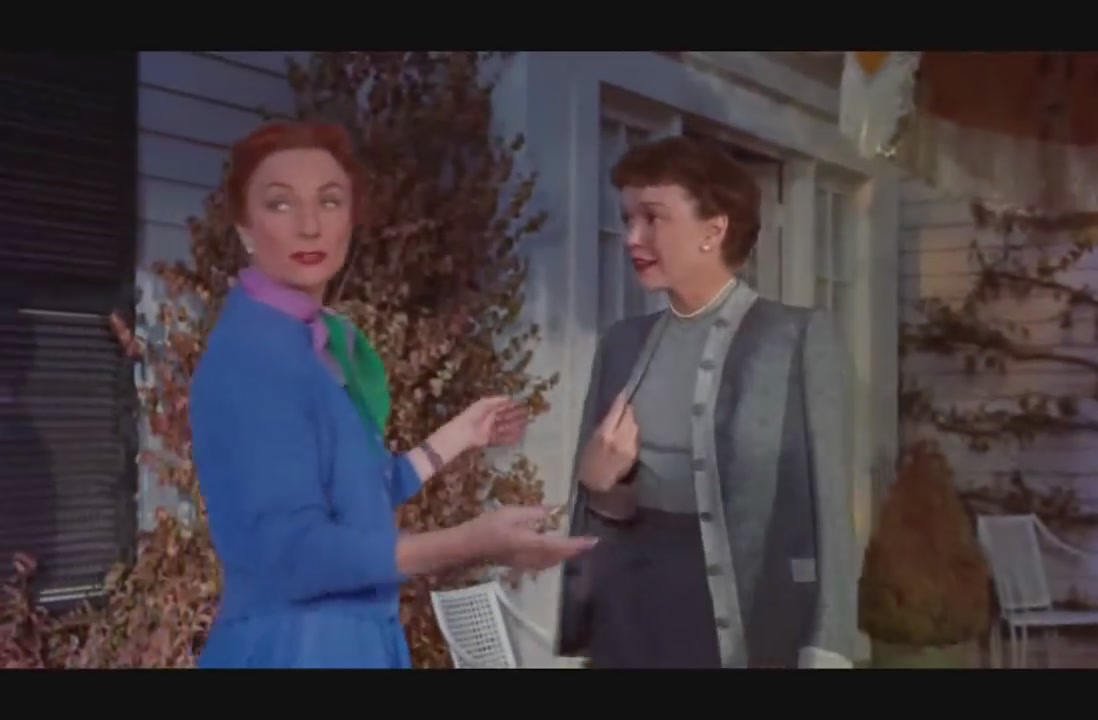 (A) |
|
|
Video 1 - Italian |
Video 2 - English |
 (B) |
|
|
Le pressioni sociali che Cary deve sopportare vengono trasferite dalla
società entro i confini di casa: sua figlia è spaventata dal vestito
rosso di Cary (Video 4 qui sotto) e le ricorda un'antica usanza
egiziana: la moglie di un re morto veniva sepolta viva con lui e tutti
gli altri suoi averi - e quando la figlia dice: "Certo che non succede
più", Cary risponde: "Davvero? Forse non in Egitto" - poiché questo è
esattamente ciò che la "comunità" suburbana borghese si aspetta da una
donna nella sua posizione: rinunciare a tutto una volta che il marito è
morto, cancellando con un solo colpo ogni pretesa di vita romantica e
sessuale. E anche suo figlio la critica per aver indossato un vestito
troppo scollato (Video 6 qui sotto). |
The social pressures Cary has to bear are carried over from society
at large into the home: her daughter is startled by Cary's red dress
(see Video 4 below), and reminds her of an old Egyptian custom - the
wife of a dead king would be buried alive with him and all his other
possessions - and when the daughter says, "Of course it doesn't happen any
more", Cary replies, "Doesn't it? Perhaps not in Egypt" - as this is
precisely what the middle-class suburban "community" expects of a woman
in her position: giving up everything once the husband is dead, erasing
by a single stroke any claim to romance and sex. And even her son
critizes her for wearing a much too low-necked dress (see Video 6
below). |
|
Video 3 - Italiano |
Video 4 - English |
|
Video 5 - Italiano |
Video 6 - English |
|
Secondo amore è insolitamente
esplicito nell'esporre le questioni in gioco, in particolare la
giustapposizione tra le "filosofie" e gli stili di vita di Ron e Cary.
Il mondo di Ron è il più lontano possibile da quello di Cary. Vive in
campagna, vicino a un vecchio mulino malconcio (vedi (C) e (D) qui
sotto), fa il giardiniere e ha in programma di ampliare la sua attività
"all'aria aperta". Come una degli amici di Ron spiega a Cary (Video 8
qui sotto), l'ambizione di Ron non è mai stata quella di fare soldi e
raggiungere una posizione sociale importante per sentirsi "sicuro". Il
suo ideale è "sii fedele a te stesso", indipendentemente dalle
convenzioni sociali, e questo è qualcosa che niente e nessuno può
torgliergli. Cary ascolta l'amica di Ron, affascinata. Ma quando in seguito Ron le chiede di sposarlo (Video 10 qui sotto), allora tocca a Cary spiegare perché l'idea è assolutamente impossibile. Ci sono altre cose importanti da considerare, oltre al loro amore: i suoi figli, il tipo di vita che Ron conduce, lasciare la posizione che ora ricopre nella società. Il loro amore non è abbastanza. Ron le ribatte prontamente che lei sta cercando di schivare la questione fondamentale perché ha paura di troppe cose ... e lei accetta con riluttanza. Cary è allo stesso tempo padrona e vittima delle pressioni sociali al conformismo - e non riesce a vedere una via d'uscita da questa contraddizione. Si notino le scelte cromatiche che accompagnano questo dialogo: all'inizio, quando Ron propone a Cary di sposarlo, l'ambiente è inondato da una luce morbida e calda; ma quando lei si allontana da lui, ed entrambi vanno verso la finestra, i loro corpi si trasformano in sagome nere contro un vetro freddo, con la neve che vediamo cadere. |
All the heaven allows is unusually explicit in exposing the issues
at stake, especially the juxtaposition between Ron's and Cary's
"philosophies" and lifestyles. Ron's world is as farther away from
Cary's as it could be. He lives in the country, near an old battered
mill (see (C) and (D) below), is a gardener and has plans to enlarge his
activities "in the open air". As one of Ron's friends explains to Cary
(see Video 8 below), Ron 's ambition has never been to make money and
reach an important social position in order to feel "secure". His ideal
is "to thy own self be true", irrespective of social conventions, and
this is something which nothing and nobody can take away from him. Cary listens to Ron's friend, fascinated. But when later on Ron asks her to marry him (see Video 10 below), then it's Cary's turn to explain why the idea is absolutely impossible. There are other important things to consider, besides their love: her kids, the kind of life that Ron leads, leaving the position that she now holds in society. Their love is not enough. Ron is quick at telling her that she's trying to dodge the important question because she's afraid of too many things ... and she reluctantly agrees. Cary is at the same time the master and the victim of the social pressures to conformity - and she cannot see a way out of this contradiction. Note the chromatic choices that accompany this dialogue: at first, when Ron proposes to Cary, they are bathed in a soft, warm light; but when she turns away from him, and both go towards the window, their bodies turn to black silhouettes against a cold window pane, with snow falling outside. |
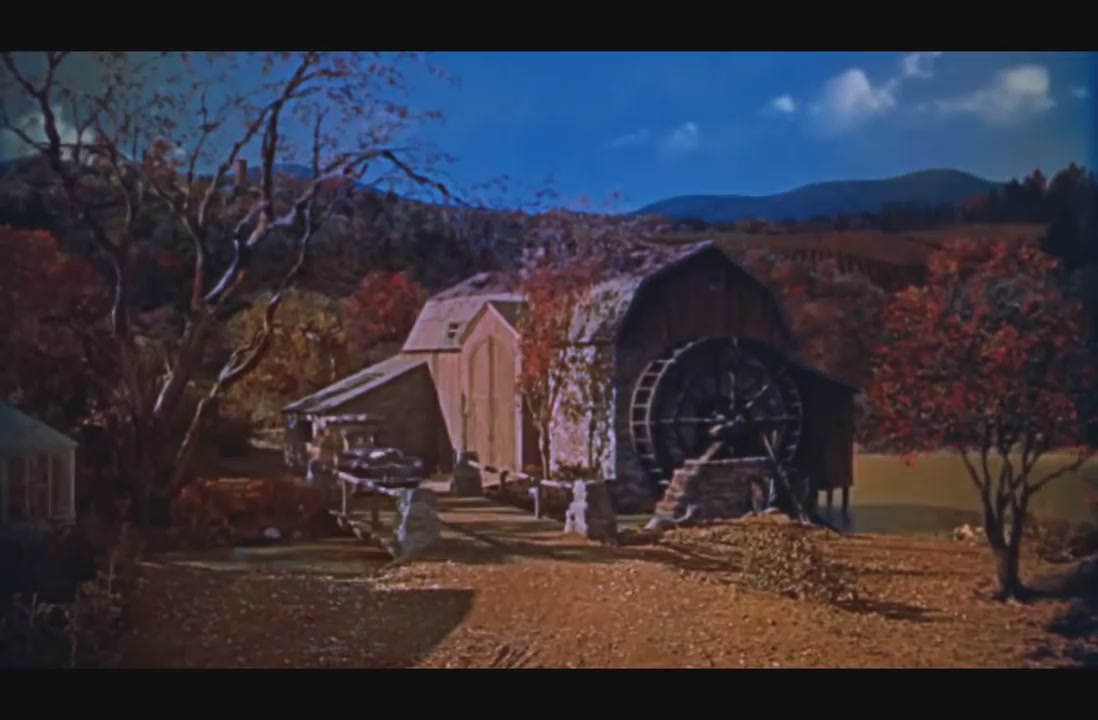
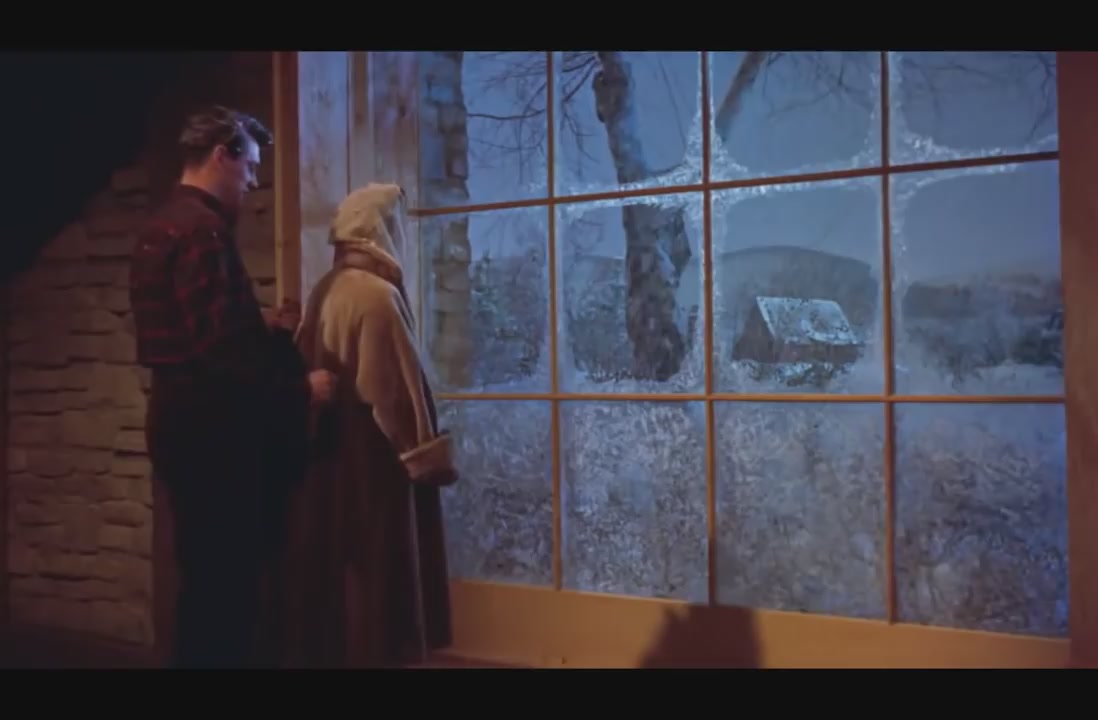 (C) (D) |
|
|
Video 7 - Italiano |
Video 8 - English |
|
Video 9 - Italiano |
Video 10 - English |
|
E Cary ha ragione nel prevedere cosa
comporterebbe il suo piano matrimoniale in termini di reazioni sociali:
la sua più cara amica cerca di convincerla che i pettegolezzi si
diffonderanno presto (Video 12 qui sotto): Ron è un giardiniere, molto
più giovane di lei, lei è una ricca vedova, e la gente potrebbe persino
pensare che Cary e Ron fossero amanti anche prima della morte del marito
di Cary ... Tali situazioni rivelano il lato orribile della natura umana
... e le voci su tutto ciò potrebbero danneggiare seriamente i suoi
figli ... Seguono poi le reazioni dei figli di Cary: suo figlio (Video 14 qui sotto) si vergognerebbe persino di portare i suoi amici a vederla, e la lascia bruscamente ... Questo dialogo si svolge in una luce fioca, con la figura di Cary incorniciata sullo sfondo di una griglia ... e quando suo figlio apre la porta per andarsene, viene inquadrato all'interno di quella stessa griglia che ora esclude completamente Cary - e le sue parole ("Non permetteremo a nulla di separarci") sono in totale contraddizione con l'immagine che la incornicia. Il rifiuto della figlia di Cary è ancora più drammatico (Video 16 qui sotto): la ragazza ammette che pensava che non le sarebbe importato dei pettegolezzi, ma in realtà ora ha scoperto che contano. E quando Cary cerca di spiegare che ama Ron, sua figlia si chiede se lo ama al punto da sacrificare la vita dei suoi figli ... Si noti, ancora una volta, l'attenta esibizione di colori tenui che giocano intorno a Cary e sua figlia, immerse in luci soffuse rosse, verdi e blu: una tavolozza di tonalità diverse che sottolinea il contrasto drammatico sperimentato dai personaggi. (Si noti anche come i contrasti di luce separano e definiscono le posizioni e le emozioni dei personaggi, come con Cary che affronta i suoi figli in (E) qui sotto). |
And Cary is right in foreseeing what her
marriage plan would involve in terms of social reactions: her closest
friend tries to convince her that gossip will soon spread (see Video 12
below): Ron is a gardener, much younger than she is, she is a rich
widow, and people may even think that Cary and Ron were lovers even
before Cary's husband's death ... Such situations reveal the hideous
side of human nature ... and the rumours about all this could seriously
damage her children ... Then follow Cary's children's reactions: her son (see Video 14 below) would even be ashamed to bring her friends to see her, and he abruptly leaves her ... This dialogue takes place in a dim light, with Cary's figure framed in the background of a grid ... and when her son opens the door to leave, he is framed within that same grid which now completely excludes Cary - and her words ("We won't allow anything to tear us apart") stand in utter contradiction to the image that frames her. Cary's daughter's rejection is even more dramatic (see Video 16 below): the girl admits that she thought she wouldn't care about gossip going round, but in fact she has now discovered that they matter. And when Cary tries to explain that she loves Ron, her daughter wonders whether she loves him to the point of sacrificing her children's life ... Notice, once again, the careful display of soft colours playing around Cary and her daughter, bathed in red, green and blue lights - a palette of different hues underlining the dramatic contrast experienced by the characters. (Notice how light contrasts separate and define the characters' positions and emotions, as with Cary confronting her children in (E) below). |
|
Video 11 - Italiano |
Video 12 - English |
|
Video 13 - Italiano |
Video 14 - English |
|
Video 15 - Italiano |
Video 16 - English |
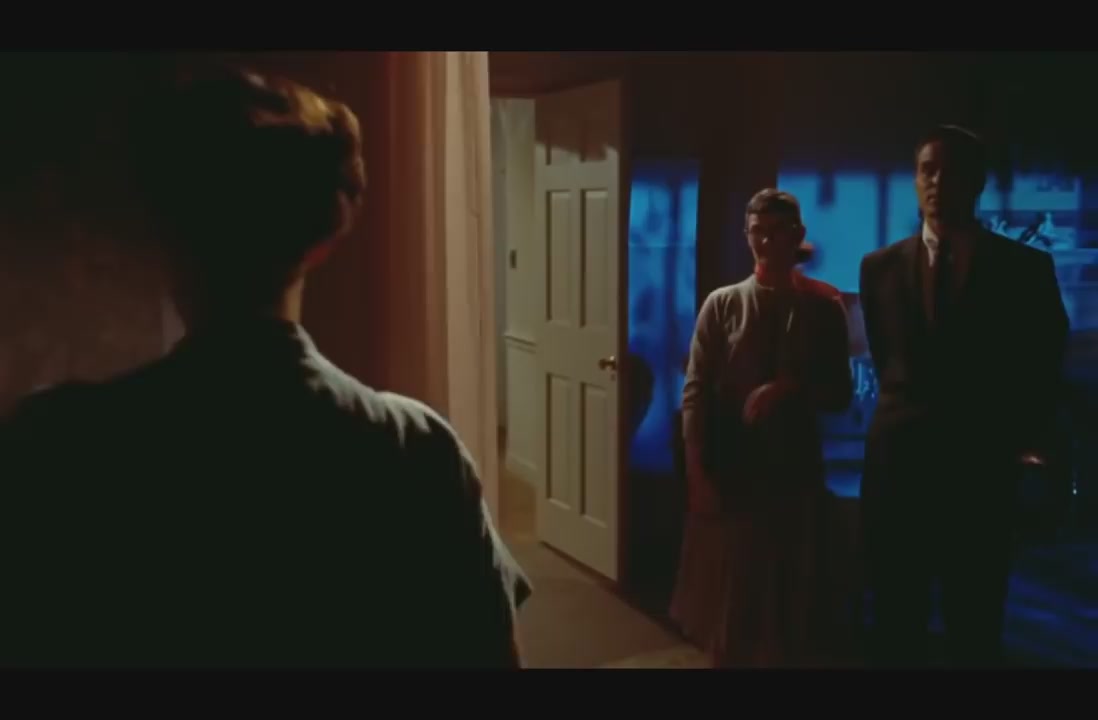 (E) |
|
|
Una volta che Cary ha deciso di lasciare Ron, a Natale i suoi figli le
fanno un regalo (Video 18 qui sotto): un televisore - con la chiara
aspettativa che troverà conforto nella sua solitudine riempiendo il suo
tempo di programmi televisivi. Il viso di Cary mostra tutta la sua
perplessità e persino l'orrore al pensiero che questo è ciò che ci si
aspetta da una donna nella sua posizione: e il suo viso viene inquadrato
nello schermo televisivo, come se la sua vita reale si stesse riducendo
a un riflesso di se stessa. E la stessa immagine si ripete quando,
lasciata sola, il suo viso si riflette in uno specchio (vedi (F) qui
sotto) e poi nei vetri delle finestre (G), con un (triste) sfondo
natalizio. Cary è ora "intrappolata" nella sua impossibilità di
conservare l'identità emotiva e sessuale di una donna, poiché la sua
immagine è spesso mostrata, come abbiamo visto, "incorniciata" da
griglie, specchi e persino uno schermo televisivo. La casa e gli oggetti
al suo interno assumono tutti un significato aggiuntivo, riproducendo e
ingrandendo le difficoltà del personaggio. |
Once Cary has decided to leave Ron, at Christmas her children give
her a present (see Video 18 below): a television set, with the clear
expectation that she will find solace in her loneliness by filling her
time with TV programs. Cary's face shows all her puzzlement and even
horror at the thought that this is what is expected of a woman in her
position: and her face becomes framed in the TV screen, as if her real
life is now being reduced to a reflection of herself. And the same image
is repeated when, left alone, her face is reflected in a mirror (see (F)
below) and then in the window panes (see (G) below), with a (sad)
Christmas background. Cary is now "trapped" in her impossibility to
retain a woman's emotional and sexual identity, as her image is often
shown, as we have seen, "framed" by grids, mirrors, and even a TV
screen. The home, and the objects within it, all take up an additional
meaning, reproducing and magnifying the character's plights. |
|
Video 17 - Italiano |
Video 18 - English |

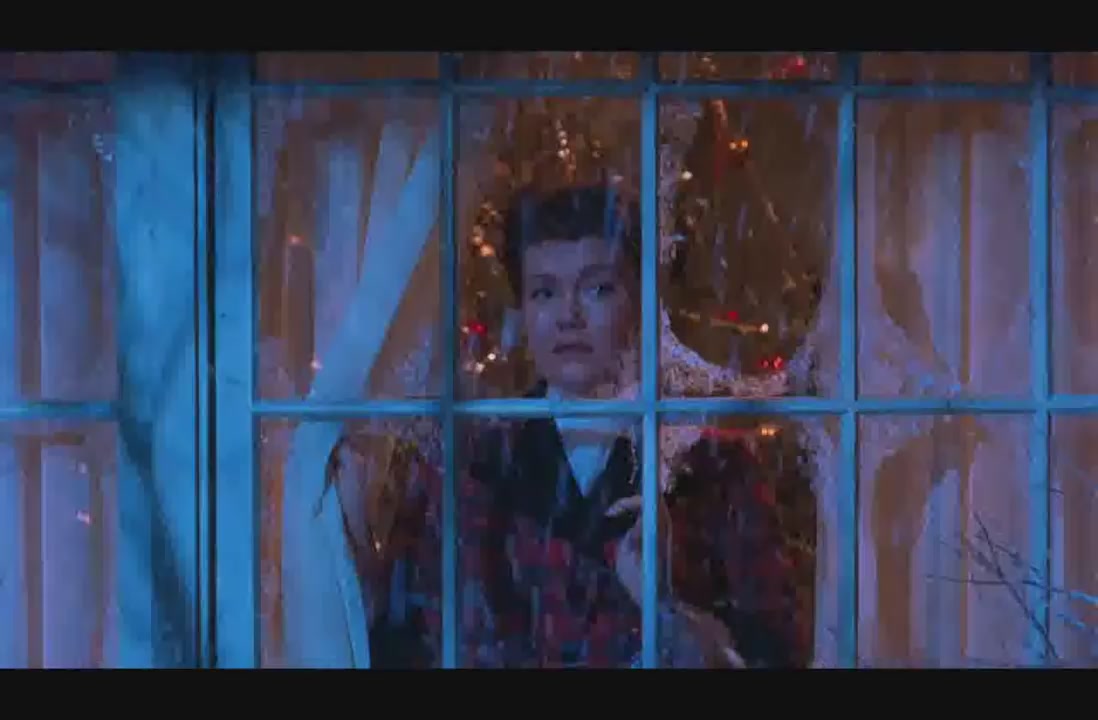 (F) (G) |
|
|
Il "lieto fine" non è privo di ambiguità (Video 20 qui sotto): quando
Ron si sveglia la mattina dopo l'incidente, ormai chiaramente in via di
recupero, Cary corre al suo fianco, e la macchina da presa si sposta
verso la finestra, dove il sole splende ora sul paesaggio innevato e un
cervo si avvicina ai vetri delle finestre: Cary ha ora abbracciato lo
stile di vita di Ron - ma ha davvero cambiato ruolo e posizione come
donna e come moglie? Dopotutto, ha rifiutato molti dei "falsi" valori
che sembravano reprimerla, ma fa ancora parte di una (nuova) famiglia
che in realtà non offre alternative - "tutto ciò che il paradiso
permette" (come dice il titolo originale del film) potrebbe non essere
così tanto dopo tutto ... |
The "happy ending" is not without its ambiguities (see Video 20
below): as Ron wakes up in the morning after the accident, now clearly
on the way to recovery, Cary runs to his side, and the camera moves
towards the window, where the sun is now shining across the snowy
landscape, and a deer comes towards the window panes: Cary has now
embraced Ron's lifestyle - but has she really changed her role and
position as a woman and as a wife? After all, she has rejected many of
the "false" values which seemed to repress her, but she is still part of
a (new) family which does not really offer any alternatives - "all
that heaven allows" may not be so much after all ... |
|
Video 19 - Italiano |
Video 20 - English |
|
"Le immagini, i riflessi e i colori
esagerati [di Sirk] servono non solo ad aumentare l'emozione, ma a
permetterci di allontanarci da esse. C'è abbastanza artificiosità nei
film di Sirk per farci capire che ciò che vediamo è una rappresentazione
artistica della vita e del suo tumulto; attraverso le immagini, ci sono
sufficienti commenti sugli infelici comportamenti delle persone verso
eventi e sentimenti per consentire a uno spettatore degli anni '50 - e
del ventunesimo secolo - di capire che il film non era la vita ma
un'immagine che la rappresenta ... Sirk immerge gli spettatori degli
anni Cinquanta nel melodramma dei suoi personaggi e contemporaneamente
crea distanza da esso, attraverso un'esagerazione emotiva e visiva in
modo da far capire loro che quello che sta accadendo sullo schermo non è
la vita, ma solo una rappresentazione in Technicolor". (Nota 1) 3. La paura mangia l'anima (Angst essen Seele auf, di Rainer Werner Fassbinder, Repubblica Federale Tedesca 1974) ---------------------------------------------------------------------------------------------------- Emmi (Brigitte Mira), una donna delle pulizie di 60 anni e vedova, trova accoglienza e poi amicizia in Ali (El Hedi Ben Salem), un marocchino Gastarbeiter (lavoratore ospite) sulla trentina. Presto Ali inizia a vivere con lei e si innamorano. Tuttavia, quando Emmi presenta Ali ai suoi figli adulti, pensano che debba essere pazza e rifiutano Ali. I problemi sorgono anche nell'appartamento di Emmi, quando il figlio del padrone di casa le dice che non può accogliere un inquilino. Per risolvere il problema, Emmi gli dice che lei e Ali si sposeranno presto - cosa che, con meraviglia di Emmi, Ali accetta prontamente. Tuttavia, questo matrimonio è considerato negativamente dagli altri inquilini e persino dai negozianti del quartiere, per non parlare dei colleghi di Emmi. Quando Emmi invita i suoi figli, ancora una volta si rifiutano di accettare il matrimonio, si arrabbiano con lei e Ali, e persino sfondano il suo televisore. Dopo una breve vacanza, durante la quale Emmi spera che le cose si calmino, scopre che i suoi amici sembrano trattarla con più rispetto. A questo punto, però, Emmi adotta nei confronti di Ali alcuni atteggiamenti paternalistici e xenofobi tipici del suo ambientei: lo trascura e diventa più severa con lui. A questo punto Ali se ne va e cerca conforto in una barista con cui apparentemente ha avuto una relazione prima di incontrare Emmi. Emmi cerca disperatamente di riavere Ali e lo visita persino al lavoro, ma viene umiliato da Ali e dai suoi colleghi. Una sera, Emmi visita il bar dove lei e Ali si sono conosciuti e iniziano a ballare "sulla loro canzone". Emmi riconosce che è vecchia e lui deve sentirsi libero di andare e venire, ma lei gli chiede solo di trattarla con gentilezza. Ali è d'accordo, ma in questo preciso istante crolla a terra e viene portato in ospedale. La scena finale vede Emmi parlare con un medico, che le dice che Ali soffre di ulcera allo stomaco, che a quanto pare è molto comune tra i lavoratori stranieri, vittime di continui stress. Ali dovrà subire un'operazione, che però non risolverà il suo problema. Emmi dice che farà qualsiasi cosa per lui, va al suo capezzale e gli tiene la mano. ----------------------------------------------------------------------------------------------------- Fassbinder non ha mai nascosto la sua ammirazione per i film di Sirk e prende Secondo amore come fonte di ispirazione. Il periodo, i personaggi e la trama sono ovviamente abbastanza diversi, ma solo in superficie: ciò che interessa a Fassbinder sono le barriere che le persone costruiscono l'una contro l'altra per una serie di motivi, e l'oppressione che ne consegue per tutti i personaggi. Cary in Secondo amore aveva dovuto combattere contro l'America suburbana tradionalista e conformista degli anni '50, che non poteva accettare che una vedova della classe media potesse sviluppare un affetto per un giardiniere di una classe inferiore. Allo stesso modo, Emmi deve combattere i pregiudizi della Germania operaia degli anni '70. Tutti intorno a lei trovano assolutamente inconcepibile che una vedova di 60 anni possa fare amicizia (per non parlare di sposarsi) con un uomo molto più giovane e, per di più, un lavoratore marocchino. Quindi viene rifiutata e umiliata proprio come lo era stata Cary. Fassbinder, tuttavia, non è interessato solo ai pregiudizi di classe: aggiunge l'ulteriore elemento di razzismo e discriminazione nei confronti dei lavoratori stranieri (di cui la Germania aveva bisogno come forza lavoro e allo stesso tempo odiava con un forte atteggiamento xenofobo) come uno degli elementi di un analisi sociale più approfondita. Anche lo stile di Fassbinder è molto diverso da quello di Sirk, sebbene trovi i suoi modi per ritrarre l'oppressione sociale e psicologica subita dai suoi personaggi. Emmi incontra Ali per la prima volta in un bar, dove una notte di pioggia cerca rifugio. Mentre entra nel bar, sentiamo suonare una canzone turca e vediamo la barista e tutti i clienti immobilizzarsi, come se l'entrata di Emmi li avesse paralizzati e trasformati in statue (Video 1 qui sotto). Nessuno parla, tutti la fissano (e noi, il pubblico, con loro), e questa messa in scena molto statica mette in luce il rifiuto che il mondo intero sembra avere per questa donna anziana, che tuttavia trova il coraggio di resistere a persone così fredde e poco invitanti. Proprio come Sirk aveva fatto "traboccare" l'eccesso di emozione in una messa in scena "eccessiva", piena di oggetti e colori, Fassbinder mostra questo "eccesso" di intolleranza in un ambiente "innaturale", dove gli attori sembrano smettere di recitare - il che ci sorprende ma ci fa anche capire ed evidenziare questa condizione sociale disumana. La distanza che Fassbinder crea tra i personaggi e noi, gli spettatori, ci rende molto consapevoli della natura oppressiva di questa comunità. |
"[Sirk's] exaggerated images, reflections, and colors serve not only to
heighten the emotion but to allow us to step back from them. There is
enough artificiality in Sirk's films for us to understand that what we
see is an artful representation of life and its turmoil; through the
images, there is enough commentary on the wretched
behavior of people towards events and feelings to
alloow a 1950s - and a twenty-first century - viewer to understand that
film was not life but an image representing it ... Sirks absorbs a 1950s
audience into his characters' melodrama and simultaneously creates
distance from it, by means of emotional and visual exaggeration in order to
allow them to understand that what's happening on screen is not life,
only a Technicolor representation." (Note 1) 3. Fear eats the soul (Angst essen Seele auf, by Rainer Werner Fassbinder, Federal Republic of Germany 1974) ---------------------------------------------------------------------------------------------------- Emmi (Brigitte Mira), a 60-year old cleaning lady and a widow, finds acceptance and then friendship in Ali (El Hedi Ben Salem), a Moroccan Gastarbeiter (guest worker) in his late thirties. Soon Ali starts living with her and they fall in love. However, when Emmi intrduces Ali to her grown children, they think she must be mad and reject Ali. Problems arise at Emmi's flat too, when the landlord's son tells her that she cannot take in a lodger. In order to solve the problem, Emmi tells him that she and Ali are getting married soon - which, to Emmi's wonder, Ali readily accepts. Still, this marriage is looked upon negatively by the other tenants and even by shopkeepers in the neighbourhood, not to mention Emmi's co-workers. When Emmi invites her children, they once again refuse to accept the marriage, get furious with her and Ali, and even smash in her Tv set. After a short holiday, during which Emmi hopes things will calm down, she finds her friends seem to treat her with more respect. At this point, though, Emmi adopts some of her friends' paternalistic and xenophobic attitudes towards Ali: she neglects him and becomes stricter with him. At this point Ali leaves and seeks comfort in a bartender he has apparently had a relationship with before meeting Emmi. Emmi desperately tries to get Ali back and even visits him at work, but is humiliated by Ali and his colleagues. One night, Emmi visits the bar where she and Ali first met and they start to dance "to their song". Emmi recognizes that she is old and he must feel free to come and go, but she asks him to be nice to each other. Ali agrees, but at this very moment he collapses to the floor and is taken to hospital. The final scene sees Emmi talking to a doctor, who tells her that Ali suffers from a stomach ulcer, which apparently is very common among stressed foreign workers. Ali will have to have an operation, which, however, will not solve his problem. Emmi says that she will do anything for him, goes to his bedside and holds his hand. ---------------------------------------------------------------------------------------------------- Fassbinder never hid his admiration for Sirk's films and takes Sirk's All that heaven allows as a source of inspiration. The period, characters and plot are obviously quite different, but only on the surface: what interests Fassbinder is the barriers that people build against each other for a variety of reasons, and the oppression that follows for all the characters. Cary in All that heaven allows had to fight against the traditionalist, conformist suburban America of the '50s, which could not accept that a middle-class widow may develop an affection for a working-class gardener. In the same vein, Emmi has to fight the prejudices of the working class Germany of the '70s. Everybody around her finds absolutely inconceivable that a 60-year-old widow might make friends with (let alone marry) a much younger man, and a Moroccan worker, on top of that. So she is rejected and humiliated just as Cary was. Fassbinder, however, is not just interested in class prejudices - he adds the further element of racism and discrimination about foreign workers (whom Germany both needed as workforce and at the same time hated with a strong xenophobic attitude ) as one of the elements of a closer social analysis. Fassbinder's style, too, is quite different from Sirk's, although he finds his own ways of portraying the social and psychological oppression suffered by his characters. Emmi first meets Ali in a bar, where one rainy night she seeks refuge. As she enters the bar, we hear a Turkish song being played and we see the bartender and all the customers freeze, as if Emmi's appearance had paralysed them and turned them into statues (see Video 1 below). No one speaks, everybody stares at her (and at us, the audience), and this very static mise-en-scène highlights the refusal the whole world seems to have for this elderly woman, who nevertheless finds the courage to stand up to such cold and uninviting people. Just as Sirk "overflowed" the excess of emotion into an "excessive" mise-en-scene full of objects and colours, Fassbinder shows this "excess" of intolerance by an "unnatural", frozen environment, where the actors seem to stop acting at all - which surprises us but also makes us capture and highlight the inhuman social condition. The distance he creates between the characters and us, the viewers, makes us very keenly aware of the oppressive nature of this community. |
|
Video 1 |
|
|
Fassbinder ha i suoi modi di smascherare le
"gabbie" dove i suoi personaggi sono intrappolati dalle convenzioni
sociali. Emmi è spesso vista "incorniciata", cioè vincolata in uno
spazio limitato, che evidenzia il suo stato di isolamento e
l'intolleranza che deve subire. Questo accade praticamente in tutti i
luoghi: a casa, anche da sola (vedi (A) qui sotto); al lavoro, dove i
suoi colleghi la evitano, rifiutando la sua decisione di vivere con Ali
(B); a casa, dove i suoi vicini si dimostrano dei pettegoli
intolleranti (C) e (D), e persino a casa con Ali (E). E il giorno del
loro matrimonio, finiscono in un ristorante dove incontrano la solita
diffidenza e disprezzo che li circondano (F). Usando sia una ripresa in
campo lungo, che ci distanzia dai personaggi, che un piano sequenza,
dove essi appaiono isolati, lontani da noi, sullo sfondo, la macchina da
presa si sofferma su di loro, obbligandoci a fissarli. Ancora una volta
Fassbinder isola i suoi personaggi che sembrano guardarci, seppure
distaccati da noi, quasi a mettere in discussione il degrado morale e
sociale che devono subire e farcelo vivere in modo diretto. "Lo spettatore, cui è negata l'emozione melodrammatica (pura gioia o pura tristezza), è lasciato a contemplare come la realtà politica e quella emotiva si intreccino; in particolare, come le differenze di nazionalità ed età tra Emmi e Ali inevitabilmente condizioneranno la loro relazione". (Nota 1) |
Fassbinder has his own ways of exposing the "cages" where his characters
are trapped by social conventions. Emmi is often seen "framed", i.e.
constrained within a limited space, which highlights her isolated status
and the intolerance she has to suffer. This happens in virtually all
places: at home, even by herself (see (A) below); at work, where her
co-workers soon shun her, refusing her resolution to live with Ali (see
(B) below); at home, where her neighbours prove to be intolerant gossips
(see (C) and (D) below), and even at home with Ali (see (E) below). And
on the day of their wedding, they end up in a restaurant where they meet
with the usual diffidence and contempt that surround them (see (F)
below). By using both a long shot and a long take, they appear isolated,
far from us, in the background, and at the same time the camera lingers
on, obliging us to stare at them. Once again, Fassbinder isolates his characters who seem to
be staring at us, yet detached from us, as if to call into question the
moral and social degradation they have to suffer and make us experience
it in a direct way. "The viewer, denied melodramatic emotion (either pure joy or pure sadness), is left contemplating how political and emotional realities intertwine; specifically, how the differences in nationality and age between Emmi and Ali inevitably will shape their love relationship." (Note 1) |
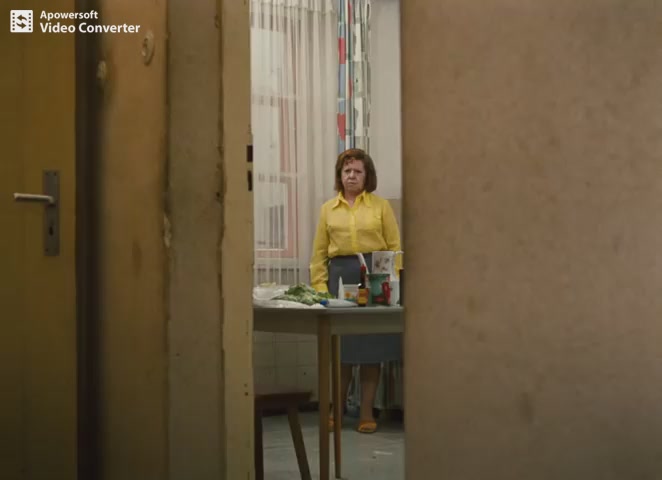 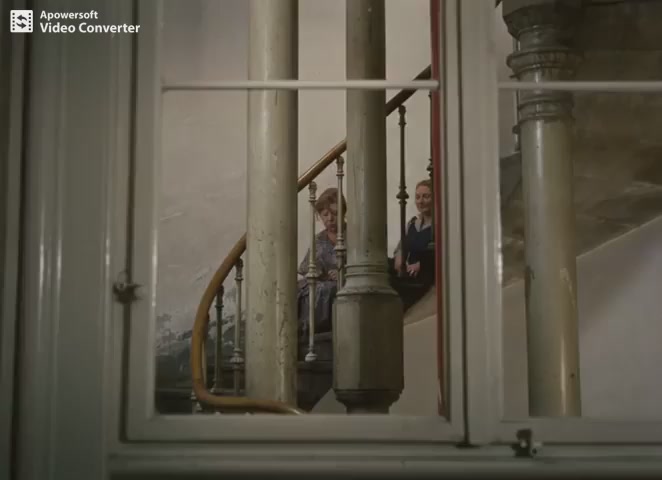 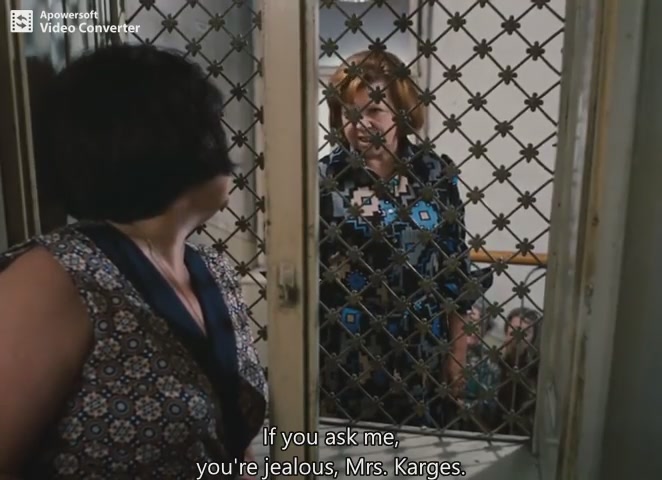 A B C 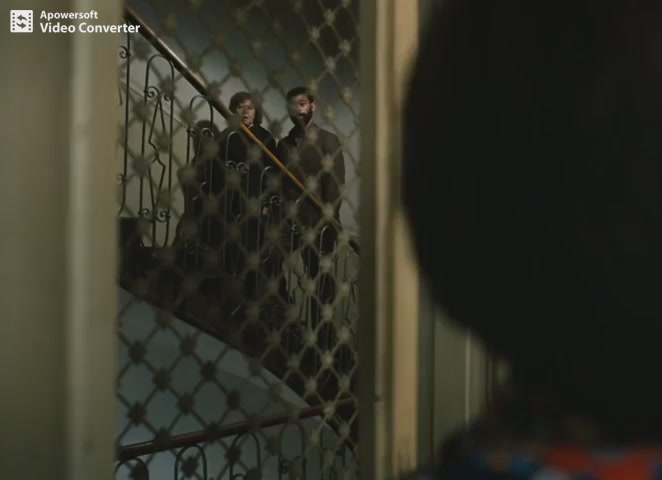 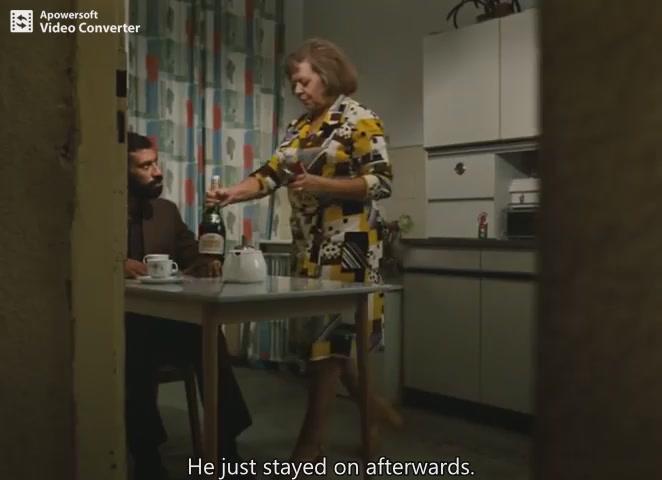 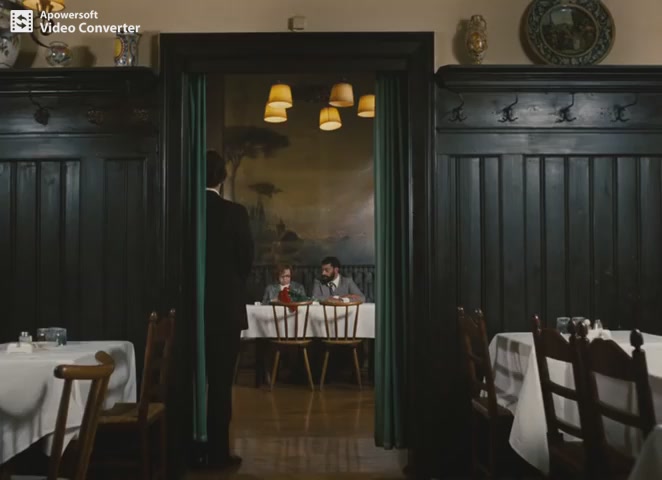
D E F |
|
|
La violenza dell'intolleranza diventa ancora più forte e dolorosa quando
Emmi affronta i suoi figli (Video 2 qui sotto) e dice loro di aver
sposato Ali: ancora una volta l'immagine è congelata, il silenzio è
insopportabile; i figli la fissano, increduli, incapaci di pronunciare
parola - finché la violenza non esplode pochi secondi dopo. È come se
l'azione si interrompesse per farci vivere e riconoscere l'artificialità
della scena, nonché il messaggio sociale e morale incarnato nel
comportamento dei personaggi. |
The violence of intolerance gets even stronger and more painful when
Emmi confronts her children (see Video 2 below) and tells them that she
has married Ali: once again, the image
is frozen, the silence is unbearable; the children stare at her, incredulous, unable to utter a
word - until the violence explodes a few seconds later. It is as if the
action stops in order for us to experience and recognize the
artificiality of the scene, as well as the social and moral message
embodied in his characters' behaviour. |
|
Video 2 |
|
|
E quando Emmi e Ali tornano dalla loro breve vacanza, scoprono che
l'atteggiamento delle persone intorno a loro è apparentemente cambiato -
ma questo è semplicemente dovuto al fatto che i figli di Emmi hanno
bisogno di lei come babysitter, che i loro vicini hanno bisogno
dell'aiuto di Ali (Video 3 qui sotto) e che il negoziante decide di
essere più cordiale per non perdere Emmi come cliente (Video 4).
Pertanto, tutte le relazioni intorno a Emmi e Ali sono basate sullo
sfruttamento e la manipolazione di ogni tipo, non sull'accettazione del
"diverso" (la differenza di Emmi nell'essere "una vecchia signora"
ancora bisognosa di un'identità romantica e sessuale, la differenza di
Ali nell'essere più giovane e, soprattutto, marocchino). |
And when Emmi and Ali come back from their short holiday, they find
that the attitude of the people around them has apparently changed -
but this is merely due to the fact that Emmi's children need her for
babysitting, that their neighbours need Ali's
help (Video 3) and that the shopkeeper decides to be more friendly in
order not to lose Emmi as a customer (Video 4). Thus, all relationships
around Emmi and Ali are based on exploitation and manipulation of all sorts, not on the
acceptance of the "different" (Emmi's difference in being "an old lady"
still in need of a romantic and sexual identity, Ali's difference in
being younger and, above all, Moroccan). |
|
Video 3 |
Video 4 |
|
Le pressioni che la coppia deve sopportare
alla fine hanno un profondo impatto anche sul loro rapporto: Emmi
diventa più severa, più intollerante, meno indulgente nei confronti di
Ali e le differenze tra loro, che amicizia e amore avevano inizialmente
offuscato, ora tornano a galla, come quando Emmi si rifiuta di cucinare
il "couscous" per Ali (Video 5 qui sotto), non solo perché non sa
cucinarlo e non le piace, ma fondamentalmente perché pensa che lui
dovrebbe abituarsi al cibo tedesco. Il divario culturale tra loro si sta
lentamente ma costantemente allargando. Non c'è da stupirsi che Ali esca
da solo, per incontrare i suoi amici "a cui piace il couscous". Questi personaggi non devono affrontare solo pressioni sociali esterne, atteggiamenti di discriminazione, xenofobia e razzismo, ma devono anche far fronte alle loro pressioni "interne". Così Emmi, desiderosa di mantenere il rispetto e l'apprezzamento sociale dei suoi amici, letteralmente "esibisce" Ali come una sorta di "strana creatura di un altro mondo" (Video 6): invita i suoi amici a "sentire i suoi muscoli", e, quando Ali, disgustato, si volta dall'altra parte, è pronta a spiegare il suo comportamento in termini che i suoi amici possano capire: "Ha i suoi stati d'animo. È la sua mentalità straniera", reintroducendo così razzismo e discriminazione anche tra lei e Ali. E ancora una volta Ali se ne va ad incontrare la sua amante, la barista. |
The pressures that the couple has to bear eventually has a deep
impact on their relationship too: Emmi becomes stricter, more
intolerant, less forgiving towards Ali and the differences between them,
which friendship and love had initially blurred, now come back to the
surface, as when Emmi refuses to cook "couscous" for Ali (see Video 5),
not just because she can't cook it and doesn't like it, but basically
because she thinks that he should get used to German food. The cultural
gap between them is slowly but constantly widening. No wonder he goes out
by himself, to meet his friends "who like couscous". These characters do not just have to face outside social pressures, attitudes of discrimination, xenophobia and racism - they also have to cope with their own, "internal", pressures. Thus Emmi, eager to retain her friends' social respect and appreciation, literally "exhibits" Ali as a sort of "strange creature from another world" (see Video 6): she invites her friends to "feel his muscles", and, when Ali, disgusted, turns away, she is ready to explain his behaviour in terms that her friends can understand: "He has his moods. It's his foreign mentality", thus reintroducing racism and discrimination even between herself and Ali. And once again Ali leaves, ready to meet his lover, the bartender. |
|
Video 5 |
Video 6 |
|
E quando Emmi lo cerca, e va al suo posto di
lavoro per parlargli, Ali finge di non conoscerla e lascia che i suoi
compagni di lavoro la prendano in giro, chiamandola "la nonna marocchina
di Ali" (Video 7 qui sotto), umiliandola profondamente. La scena finale si svolge all'ospedale (Video 8), dove presto Ali verrà operato. Come abbiamo detto, il medico è molto chiaro nello spiegare la natura e le prospettive della malattia di Ali, per la quale non sembra esserci alcuna cura (eccetto l'intervento chirurgico), poiché è il risultato del costante stato di stress di questi lavoratori stranieri. Eppure Emmi dice che "farò tutto ciò che è in mio potere" - a questo punto la macchina da presa ingrandisce uno specchio, in cui vediamo il riflesso di Emmi che si avvicina al capezzale di Ali. Non li vediamo mai realmente se non attraverso questo specchio, come se il mondo di Emmi e Ali non potesse essere reale ma dovesse continuare ad essere una "imitazione della vita". E, proprio come la scena finale di Secondo amore aveva visto Cary accanto al letto di Ron, promettendogli il suo aiuto e il suo amore, così qui vediamo Emmi venire a patti con il suo uomo: deve accettare il suo ruolo, principalmente come infermiera e assistente, poiché questo è probabilmente il massimo che le pressioni sociali e le convenzioni le permettono di avere. Ancora una volta, è il ruolo e la posizione della donna che emergono più chiaramente da entrambi i film: all'interno di una società governata dalle rigide regole del conformismo tradizionale, è la donna che deve pagare il prezzo più alto. |
And when Emmi looks out for him, and goes to his workplace to talk
to him, Ali pretends not to know her and lets his workmates make fun of
her, calling her "Ali's Moroccan grandmother" (see Video 7), deeply
humiliating her. The final scene takes place at the hospital (see Video 8), where Ali is soon to have an operation. As we said, the doctor is very clear in explaining the nature and prospects of Ali's illness, for which there seems to be no cure (except operations) since it is a result of these foreign workers' constant state of stress. Yet Emmi says that "I'll do everything in my power" - at this point the camera zooms in on a mirror, in which we see the reflection of Emmi approaching Ali's bedside. We never actually see the two of them except through this mirror, as if Emmi and Ali's world could not be real but must continue to be an "imitation of life". And, just like the final scene of All that heaven allows saw Cary next to Ron's bedside, promising her help and love, so here we see Emmi coming to terms with her own man - she must accept her role, primarily as a nurse and a caretaker, since this is probably the most that social pressures and conventions allow her to have. Once again, it's the woman's role and position that emerge most clearly from both films: within a society governed by strict rules of traditional conformism, it is the woman who must pay the bigger price. |
|
Video 7 |
Video 8 |
|
3. Lontano dal paradiso
(di Todd Haynes, USA/Francia 2002) Secondo amore di Douglas Sirk è davvero un caso particolare nella storia del cinema, dal momento che non è stato solo l'ispirazione per La paura mangia l'anima di Fassbinder, ma anche la fonte di un nuovo progetto del regista Todd Haynes, che non voleva essere né un semplice "remake "del film originale, né un semplice "omaggio" a un regista molto apprezzato. Lontano dal paradiso è in effetti vagamente basato sulla trama di Sirk, ma aggiunge nuovi significati e usa il melodramma come un genere del passato che ha molto da raccontare sul nostro presente. ----------------------------------------------------------------------------------------------------- 1957, periferia di una piccola città del Connecticut. Cathy (Julianne Moore) è l'immagine della moglie, madre e casalinga perfetta, sposata con Frank (Dennis Quaid), un uomo d'affari di successo: la perfetta famiglia americana degli anni '50. Poi una notte, quando Frank deve restare in ufficio fino a tardi, Cathy decide di portargli la cena e lo trova che bacia appassionatamente un altro uomo. Il mondo sembra crollare - Frank accetta di avviare un programma di terapia per curare la sua "malattia", ma il suo rapporto con Cathy è irrimediabilmente compromesso e presto si dà all'alcool. Nel frattempo, Cathy fa amicizia con un afroamericano, Raymond (Dennis Haysbert), il figlio del defunto giardiniere di Cathy: iniziano a vedersi, anche in luoghi pubblici, dove la loro presenza viene immediatamente notata dai vicini ed è subito oggetto di pettegolezzi nella cittadina. Profondamente turbata da tutto questo, Cathy dice a Raymond che "la loro relazione non è plausibile" e pensa di lasciarlo. Frank decide finalmente per una relazione gay stabile e chiede il divorzio da Cathy. Quando Cathy va a trovare Raymond, viene a sapere che sua figlia è stata schernita e aggredita da tre ragazzi bianchi, e che ultimamente hanno scaglliato dei sassi contro le sue finestre; inoltre, anche la comunità afroamericana non lo sostiene. Quindi, quando Cathy suggerisce che possono stare insieme ora che è lei è libera, Raymond risponde che è troppo tardi - "Ho imparato la lezione sul mescolare mondi diversi" - ed è ora pronto a partire per Baltimora. Cathy ora non può far altro che andare alla stazione, salutando Raymond silenziosamente con la mano mentre il treno si allontana. ----------------------------------------------------------------------------------------------------- Le sequenze iniziali (Video 1 qui sotto) stabiliscono non solo l'ambientazione ma l'atmosfera dell'intero film. Quello che ci colpisce fin dall'inizio è l'uso del colore: una ricca tavolozza di giallo, marrone e oro, in cui le sequenze sembrano immerse, ma che suggeriscono anche l'aspetto "autunnale" della scena (e della vicenda). La musica, una melodia romantica, acquista forza e fascino emotivo man mano che le sequenze procedono. Gli spettatori che hanno familiarità con i melodrammi di Sirk avranno già riconosciuto tali dispositivi stilistici. La macchina da presa si sofferma più di quanto sarebbe necessario sull'immagine della stazione ferroviaria, che, come sappiamo, sarà anche il contesto finale della storia. E facciamo così la conoscenza di Cathy, o meglio, del suo ruolo e del suo status in questa comunità: fare la spesa, prendersi cura dei bambini, aiutata da una cameriera afro-americana, e aspettare che suo marito torni a casa dal lavoro. Proprio come nella sequenza iniziale di Secondo amore, vediamo un'amica di Cathy andarla a trovare. |
3. Far from heaven (by Todd Haynes, USA/France 2002) Douglas Sirk's All that heaven allows is indeed a particular case in film history, since it was not only the inspiration for Fassbinder's Fear eats the soul, but the source of a new project by director Todd Haynes, who meant it to be neither a simple "remake" of the original movie, nor a mere "homage" to a much appreciated filmmaker. Far from heaven is indeed loosely based on Sirk's plot, but adds new meanings and uses melodrama as a genre from the past which has a lot to tell about our present. ---------------------------------------------------------------------------------------------------- 1957, the suburbs of a small town in Connecticut. Cathy (Julianne Moore) is the image of the perfect wife, mother, and housewife, married to Frank (Dennis Quaid), a successful businessman - the perfect American family of the '50s. Then one night, when Frank has to stay late at the office, Cathy decides to bring him his dinner, and finds him passionately kissing another man. The world seems to collapse - Frank agrees to start a therapy program to cure his "disease", but his relationship with Cathy is irretrievably lost, and he turns to alcohol. Meanwhile, Cathy gets friendly with an African American, Raymond (Dennis Haysbert), the son of Cathy's late gardener and they start seeing each other, even in public places, where their presence is immediately noticed by neighbours and made the topic of widespred gossip around town. Deeply disturbed by all this, Cathy tells Raymond that "their relationship isn't plausible" and plans to leave him. Frank finally decides for a stable gay relationship and seeks a divorce from Cathy. When Cathy goes to see Raymond, she learns that his daughter has been taunted and assaulted by three white boys, and that he has been getting rocks in his windows lately; besides, even the African-American community isn't backing him up. So, when Cathy suggests that they can be together now that she is single, Raymond answers that it is too late - "I've learned my lesson about mixing in other worlds" - and is now ready to leave for Baltimore. Cathy can now just go to the station to see Raymond off, waving a silent goodbye to him as the train leaves the station. ---------------------------------------------------------------------------------------------------- The beginning sequences (see Video 1 below) establish not just the setting but the mood of the entire film. What strikes us right from the start is the use of colour: a rich palette of yellows, browns and golds, in which the sequences seem bathed, but which also set the "autumnal" look of the scene (and of the story). The music, a romantic tune, gains in strength and emotional appeal as the sequences progress. Viewers familiar with Sirk's melodramas will have already recognized such stylistic devices. The camera lingers for more than would be necessary on the image of the railway station, which, as we know, will also be the ending context of the story. And finally, we immediately get to know Cathy, or rather, her role and status in this community - shopping, caring for the children, helped by an African-American maid, and waiting for her husband to come home from work. Just as in the initial sequence of All that heaven allows, we also get to see a friend of Cathy's driving to her house to meet up with her. |
|
Video 1 |
|
|
Il trailer (Video 3 qui sotto) pone prontamente le giuste
domande su cosa si nasconde sotto un paesaggio così "idilliaco": "Cosa
c'è sotto la superficie?", "Cosa si nasconde dietro i muri di casa?",
"Cosa imprigiona i desideri del cuore? ". Siamo proprio nel regno del
melodramma: personaggi desiderosi di affermare i propri diritti alla
vita e all'amore, ma che non possono (o non vogliono?) far fronte ai
vincoli in cui sono imprigionati dalle pressioni sociali e dai
pregiudizi culturali; personaggi che si pongono obiettivi "impossibili"
e che alla fine scopriranno che tale "impossibilità" distruggerà le loro
vite. |
The trailer (see Video 3 below) readily asks the right questions
about what lies beneath such an "idyllic" landscape: "What lies under
the surface?", "What hides behind the walls?", "What imprisons the
desires of the heart?". We are just in the realm of melodrama:
characters who are eager to affirm their rights to life and love, but
cannot (will not?) cope with the constraints that social pressures and
cultural bias have strictly planned for them; characters that set
themselves "impossible" targets, and will eventually discover that such
"impossibility" will destroy their lives. |
|
Video 2 - Italiano |
Video 3 - English |
|
Nel Video 4 qui sotto, le questioni di
discriminazione sociale sono chiaramente giustapposte: mentre Frank ha
(almeno temporaneamente) messo da parte le sue tendenze gay, è furioso
con Cathy perché in città si è diffuso il pettegolezzo che Cathy sta
incontrando un uomo di colore. Frank è molto chiaro sul suo ruolo e su
cosa si aspetta da Cathy (e cosa si aspettano gli altri da lui): "Non
capisci quali conseguenze tutto questo può avere su di me e sulla
reputazione che negli ultimi otto anni ho provato a costruire per te,
per i bambini e per l'azienda? ". E quando Cathy cerca di dire: "L'idea
di una donna bianca che parla con un uomo di colore ...", Frank la
interrompe bruscamente: "Per favore, risparmiami i diritti dei neri!". E le implicazioni pratiche di tutto ciò sono chiaramente mostrate nel Video 5, dove Raymond e Cathy si incontrano in una tavola calda e vengono fissati dal barista e da tutti gli altri ospiti - la pressione dei pregiudizi sociali è tutta nell'atmosfera pesante che si crea quando questa coppia "inaccettabile" entra nel bar (si confronti il contesto simile di Emmi che entra nel bar in La paura mangia l'anima) - costringendoli alla fine ad andarsene. Ma anche per strada, mentre discutono della loro relazione e di ciò che potrebbe comportare, Raymond viene individuato dai passanti che iniziano ad offenderlo, e la coppia si separa rapidamente. |
In Video 4 below, social discrimination issues are clearly
juxtaposed: while Frank has (at least temporarily) set aside his gay
tendencies, he is furious with Cathy because gossip has spread around town that Cathy is meeting a black man. Frank is very clear about
his role and what he expects from Cathy (and what others expect from
him): "Don't you understand what consequences all this can have on me,
and on the reputation that in the past eight years I've been trying to
build for you, for the children and for the company?". And when Cathy
tries to say, "The idea of a white woman talking to a coloured man ...",
Frank abruptly interrupts her: "Please, spare me black people's
rights!". And the practical implications of all this are clearly showed in Video 5, where Raymond and Cathy meet in a diner and are stared at by the bartender and all the other guests - the pressure of social prejudices is all in the heavy atmosphere that sets in when this "unacceptable" couple enters the bar (compare the similar context of Emmi entering the bar in Fear eats the soul) - which eventually forces them to leave. But even in the street, as they discuss their relationship and what this might entail, Raymond gets singled out by passers-by who start call him names, so that he and Cathy quickly part. |
|
Video 4 |
Video 5 |
| Il triste finale alla stazione (Video 6 qui sotto) è reso particolarmente straziante quando Cathy cerca, all'ultimo minuto, di trovare Raymond, solo per poter scambiare uno sguardo - nessuna parola viene detta, come se tutto fosse già stato stato detto, e a questi due amanti resta solo un lacerante saluto con la mano. La musica sommessa sul binario della stazione aumenta gradualmente di tono e volume mentre guardiamo Cathy uscire dalla stazione, oltrepassarla e allontanarsi. |
The sad ending at the station (see Video 6) is made particularly
excruciating as Cathy first tries, at the very last minte, to find
Raymond, only to be able to exchange glances with him - no word is
spoken, as if everything had already been said, and these two lovers are
left only with a lacerating waving of their hands. The subdued music on
the station platform gradually increases in tone and volume as we watch
Cathy exit the station, walk past it and drive away. |
|
Video 6 |
|
| "Lontano dal paradiso è sia una lettera d'amore al melodramma del passato sia una celebrazione della continua rilevanza e della vitalità del genere" (Nota 2) | "Far from heaven is both a love letter to past melodrama and a celebration of the genre's enduring relevance and vitality" (Note 2) |
|
Il regista Haynes ha chiaramente avuto in
mente Secondo amore durante le riprese di Lontano dal
paradiso: il suo uso dei costumi, i colori saturi, le luci
fortemente contrastate, la messa-in-scena e il commento musicale ci
ricordano inequivocabilmente il film di Sirk. Ovviamente, argomenti e
temi che non potevano essere mostrati esplicitamente negli anni '50
(come le relazioni interrazziali e le storie d'amore gay) possono ora
avere un posto di rilievo, ma questa è probabilmente solo una differenza
superficiale: ciò che Haynes ha da dire sulle pressioni sociali e sui
diritti individuali è ancora un tema importante. Ma il trattamento delle
emozioni è un po 'diverso: i suoi personaggi non mostrano tutto ciò che
potrebbero, così i sentimenti diventano più riservati e più laceranti
allo stesso tempo. 4. Conclusione Lo stesso tema di base - come la libertà individuale è repressa dalle convenzioni sociali e dalle discriminazioni - è alla base di tutti e tre i film di cui abbiamo discusso, sebbene sia trattato in modo diverso: Sirk fa "traboccare" le emozioni nell'ambiente circostante, in modo che tutti gli elementi della messa-in-scena diventano "sostituzioni viventi" di ciò che accade ai personaggi; Fassbinder è più direttamente interessato alla critica sociale, ma, attraverso i suoi "effetti distanziatori" è in grado di renderci pienamente e dolorosamente consapevoli delle emozioni dei personaggi; e Haynes porta gli elementi melodrammatici classici a nuova vita, infondendoli con una sensibilità che può benissimo incidere sul pubblico contemporaneo. Eppure i tre film possono essere giustamente considerati "melodrammi", in quanto le emozioni che trasmettono, attraverso mezzi così diversi, rendono i loro personaggi vivi, con le loro passioni e le loro difficoltà, mentre allo stesso tempo denunciano le contraddizioni che devono subire e che sono in gran parte responsabili di quelle stesse emozioni. "Realizzato all'inizio del ventunesimo secolo, [Lontano dal paradiso] è ambientato nello stesso periodo del film di Sirk e tiene ben presente anche il film di Fassbinder. Le questioni affrontate nel film sono articolate sia nel modo in cui le conosciamo ora sia nel modo in cui potevano essere vissute allora, o, più precisamente, nel modo in cui Haynes, Fassbinder e il loro spettatori li hanno vissuti attraverso i film di Sirk. Ambientando il film nel periodo di Sirk, Haynes non può aggiornare apertamente gli anni '50 ai primi anni 2000, come fa Fassbinder ambientando [La paura mangia l'anima] nella Germania degli anni '70. Haynes può usare gli anni '50 come specchio dei primi anni 2000 e creare una sorta di effetto "ping-pong" direttamente con il film di Sirk e indirettamente con quello di Fassbinder. Lontano dal paradiso, quindi, cambia i suoi personaggi e la sua narrazione in modi sobri e spesso altamente ironici ". (Nota 3) |
Director Haynes has clearly had All that heavens allows on
his mind while shooting Far from Heaven: his use of costume,
saturated colours,
high-contrast lighting, mise-en-scène and music do remind us unequivocally of Sirk's
film. Obviously, topics and themes that could not be explicitly shown in
the '50s (like overt interracial relationships and gay romances) can now
figure prominently, but this is probably only a superficial difference:
what Haynes has to say about social pressures and individual rights is
still a major theme. But the treatment of emotions is somewhat
different: his characters do not show all they could, so that feelings
become more restricted and more lacerating at the same time. 4. Conclusion The same basic theme - how individual freedom is repressed by social conventions and overt discrimination - lies at the basis of all the three films we have discussed, although treated differently: Sirk makes emotions "overflow" into the surrounding environment, so that all elements of the mise-en-scène become "living replacements" of what happnes to the characters; Fassbinder is more directly interested in social critique, but, through his "distancing effects" is able to make us fully and painfully aware of the characters' emotions; and Haynes brings the classical melodramatic elements into new life, infusing them with a sensibility that can very well resonate with contemporary audiences. And yet the three films can rightly be considered "melodramas", in so far as the emotions they convey, through such different means, make their characters alive with their passions and their plights (for the audience, too), while at the same time exposing the contradictions that they have to suffer, and which are largely responsible for those very same emotions. "Made in the early twenty-first century, [Far from Heaven] is set in the same period as Sirk's film and has Fassbinder's film on its mind as well. The issues faced in the film are articulated by the way we know them now and the way they may have been experienced then, more accurately, the way Haynes, Fassbinder, and their audiences experienced them through Sirk's films. By setting the film in Sirk's period, Haynes can't openly bring the 1950s up to date to the early 2000s, the way Fassbinder does by setting [Fear eats the soul] in 1970s Germany. Haynes can use the 1950s as a mirror for the early 2000s and create a kind of ping-pong effect directly with Sirk's film and indirectly with Fassbinder's. Far from heaven, therefore, changes its characters and its narrative in quiet and often highly ironic ways." (Note 3) |
Note/Notes
(1) Woodward K.S. 1991. "European anti-melodrama: Godard, Truffaut, and Fassbinder" in Landy M. (ed.) Imitation of life. A reader on film and television melodrama, Wayne State University Press, Detroit, p. 587.
(2) Cook P. 2007. "Far from heaven" in Cook P. (ed.) The cinema book. British Film Institute, London, p. 332.
(3) Kolker R.P. 2006. Film, form and culture, Routledge, London and New York, p. 282.
 |
Per
saperne di più ... * Dal sito Wikipedia: - Douglas Sirk - Rainer Werner Fassbinder - Todd Haynes - Secondo amore - La paura mangia l'anima - Lontano dal paradiso * Dal sito The Vision: - Perchè "La paura mangia l'ama" di Fassbinder è ancora oggi il film più efficace sul razzismo di Andrea Tiradritti |
 |
Want to know more? * From Wikipedia: - Douglas Sirk - Rainer Werner Fassbinder - Todd Haynes - All that heaven allows - Ali: Fear eats the soul - Far from heaven * From the Rottentomatoes website: - All that heaven allows - Ali: Fear eats the soul - Far from heaven * From Roger Ebert's website: - Ali: Fear eats the soul - Far from heaven |